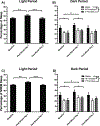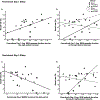Impacts of sex and the estrous cycle on associations between post-fear conditioning sleep and fear memory recall
- PMID: 31593790
- PMCID: PMC6903696
- DOI: 10.1016/j.bbr.2019.112156
Impacts of sex and the estrous cycle on associations between post-fear conditioning sleep and fear memory recall
Abstract
Women are at greater risk than men for developing posttraumatic stress disorder (PTSD) after trauma exposure. Sleep, especially rapid-eye-movement sleep (REMS), has been considered a contributing factor to the development of PTSD symptoms through its effects on the processing of emotional memories. However, it remains unknown if sex and sex hormones play a role in the hypothesized impact of sleep on the development of PTSD. Animal models have methodological advantages over human studies in investigating this research question; however, animal models of sleep in PTSD have been tested only with males. C57BL/6 mice (7 males and 15 females) were exposed to 15 footshocks in a footshock chamber, and 5 min after the last footshock, were returned to their home cages for telemetric electroencephalographic sleep recording. Nine to thirteen days later, mice were returned to the footshock chamber for 10 min without footshocks. Fear recall rates were computed by comparing freezing behaviors in the footshock chamber immediately after the footshocks to those during fear context reexposure. Males had significantly lower recall rates compared to metestrous females (that received footshocks on metestrus). Overall, males slept more than both proestrous females (that received footshocks on proestrus) and metestrous females during the dark period. Regression analyses revealed that average REMS episode durations after footshocks were differentially associated with recall rates across groups, such that the association was positive in males, but negative in proestrous females. Results suggest that both sex and the estrous cycle modulate the associations between REMS continuity and fear memory consolidation.
Keywords: Estrous cycle; Fear conditioning; Mouse; PTSD; Sex difference; Sleep.
Copyright © 2019 Elsevier B.V. All rights reserved.
Figures




References
-
- American Psychiatric Association Diagnostic and Statistical Manual of Mental Disorders, 5th ed., American Psychiatric Association, Washington, DC, 2013.
-
- Kessler RC, Sonnega A, Bromet E, Hughes M, Nelson CB, Posttraumatic stress disorder in the national comorbidity survey, Arch. Gen. Psychiatry 52 (1995) 1048–1060. - PubMed
Publication types
MeSH terms
Grants and funding
LinkOut - more resources
Full Text Sources

